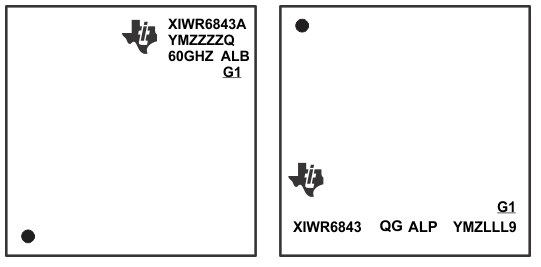SWRA656C May 2020 – October 2022 AWR6843 , AWR6843AOP , IWR1642 , IWR1843 , IWR6443 , IWR6843 , IWR6843AOP
- Migrating to xWR68xx and xWR18xx Millimeter Wave Sensors
- Trademarks
- 1Introduction
- 2xWR1843 Hardware/Software Migration
- 3xWR6843AoP ES2.0 Migration
- 4Helpful Resources
-
5Code Snapshots
- 5.1 SDK 3.3 API Change for MMWave_open
- 5.2 SDK 3.3 API Change for ADCBuf_open
- 5.3 SDK 3.3 API Change for CANFD_init
- 5.4 SDK 3.3 68xx Secondary Bootloader Update
- 5.5 SDK 3.3 16xx vs 68xx: Calibration Frequency Update
- 5.6 SDK 3.3 16xx vs 68xx: SoC Definition Updates
- 5.7 SDK 3.3 16xx vs 18xx: SoC Definition Updates
- 5.8 SDK 3.4 xWR68xx Calibration Frequency Update
- 5.9 SDK 3.4 Object Detect HWA DPC Range FFT Scaling
- 5.10 SDK 3.4 Object Detect Range HWA DPC Radar Cube Format
- 5.11 xWR6843AoP ES1.0 Antenna Geometry
- 5.12 xWR6843AoP ES2.0 Antenna Geometry
- 5.13 xWR6843AoP ES2.0 Antenna Geometry Code Update
- 5.14 Antenna Geometry Structure Usage in mmw demo
- 5.15 xWR6843AoP ES2.0 RX Channel Phase Compensation
- 6References
- 7Revision History
3.1 Hardware Changes From xWR6843AoP ES1.0 to xWR6843AoP ES2.0
The changes described in this section are relevant when migrating xWR6843AoP ES1.0 hardware to xWR6843AoP ES2.0. Figure 3-1 shows the device symbolization change from ES1.0 to ES2.0 on device part marking.
Left side device marking shows ES1.0 silicon and right side device marking shows ES2.0 silicon. For more details on the device marking, see the xWR6843 Device Errata, Silicon Revisions 1. and 2.0.
 Figure 3-1 Silicon Device Marking Difference Between xWR6843AoP ES1.0 and ES2.0
Figure 3-1 Silicon Device Marking Difference Between xWR6843AoP ES1.0 and ES2.0Table 3-1 xWR6843AoP ES1.0 to xWR6843AoP ES2.0 Hardware Changes
| No | Summary | xWR6843AoP ES1.0 | xWR6843AoP ES2.0 |
|---|---|---|---|
| 1 | QSPI interface speed has been improved. This enables faster boot loading, note that supported flashes are listed in the Flash Variants Supported by the mmWave Sensor. | Max 40 MHz | Max 80 MHz |
| 2 | Boot loader enhancement has been made. This allows faster boot and stability across devices | Boot loader code used to do the APLL calibration | Closed loop APLL calibration will be done by BSS |
| 3 | Tx beam scanning is introduced | No support | Supported |
| 4 | Memory compression (Depending upon the compression ratio of the RADAR data cube larger memory would be available for code and remaining data) | No support | Supported |
| 5 | Calibration is supported (This improves the performance and stability of the device across temperature) | No Calibration | Calibration supported |
| 6 | Clock gating at power-up and IP clock gating based on use-case, this should improve the power saving | No clock gating | Clock gated on unused peripherals. Device low level drivers un-gates the clock depending upon the peripheral used |
| 7 | RF Improvements –RX NF (Improved range and accuracy) | Baseline | Improved (Please refer to the data sheet for exact number) |
| 8 | RF Improvements –CLK PN (Improved accuracy) | Baseline | Improved (Please refer to the data sheet for exact number) |
| 9 | Package change | Baseline | Improved package (Please refer to the data sheet for detailed package information) |
| 10 | Changes in Antenna virtual Array | Baseline | Improvement in package routing caused changes in the antenna elements, hence there is change in virtual antenna array between ES1 and ES2.0. See Table 3-2 |